US demand for W. African Khaya (mahogany) appeared
to be improving mid-year but the anticipated continued
increase in demand did not materialised.
2.
GHANA
Ghana¡¯s timber export performance
According to Ghana Timber Industry Development
Division (TIDD) report, a total of Euro 8,439 million was
realised from a volume of 24,116 cu.m of wood products
exported in September this year. The corresponding
figures for September 2010 were Euro 12,618 million, and
36,000 cu.m indicating that 20011 exports fell by around
33% in value and in volume.
For the first nine months of 2011, wood product exports
fell by 18 percent in value and 16 percent in volume (Euro
85,923 million and 259,151 cu.m) when compared to the
same period in 2010.
The decline, says the TIDD, was mainly the result of an
inadequate supply of logs, coupled with operational
challenges faced by most sawmillers.
During the first three quarters exporters shipped about
sixteen different wood products as shown in the table
below.
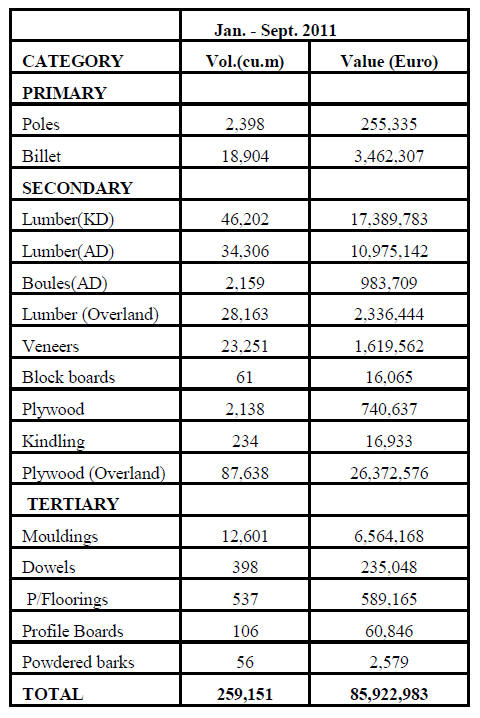
Markets within Africa accounted for around 50 percent of
all wood product exports by Ghana in the first three
quarters of the year with Europe and four other markets
accounting for the balance. The main product exported to
regional markets was plywood and this went mainly to
Nigeria, Burkina Faso, Togo and Niger.
The table below shows the pattern of market distribution
from Ghana¡¯s wood products.
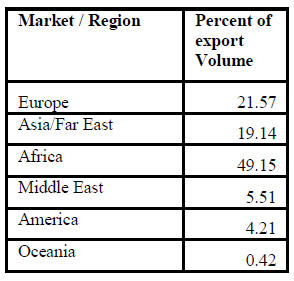
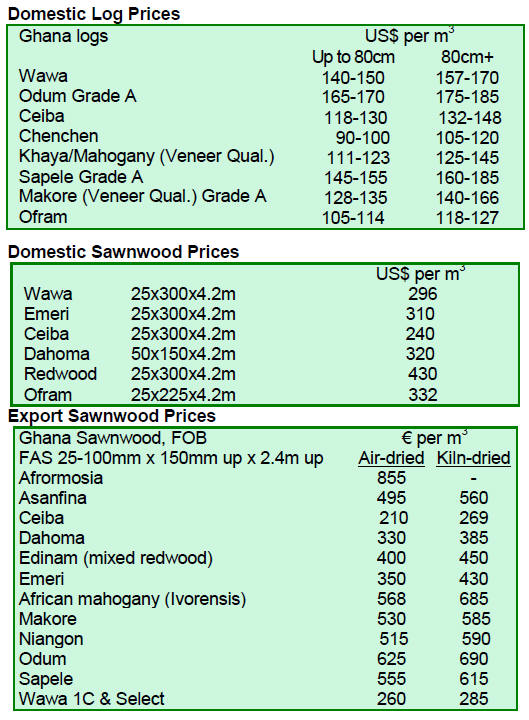
3.
MALAYSIA
2011 export target can be meet says Minister
The Malaysian Plantation and Commodities Ministry said
that the Malaysian timber industry is projected to meet its
export target of RM20 billion to RM21 billion, which is
close to the RM20.5 billion exports in 2010.
The Malaysian timber industry is still battling the effects
of the 2009 global financial crisis and weakness in the US
economy as well as the effects of the Euro debt crisis,
which have given rise to weak demand for Malaysian
timber products in affected markets.
In addition, unrest in some Middle East countries has
added to the toll on the Malaysian timber industry.
The Ministry added that local timber consumption stands
at about RM7 billion per year, with demand coming
mainly from the local building and construction sector.
Encouraging furniture export earnings as markets are diversified
Exports of Malaysian made furniture products are likely to
be between RM7 billion to RM7.5 billion this year
compared with RM7.95 billion last year says the
Malaysian Furniture Entrepreneurs Association (MFEA).
The association had projected a 15% drop in exports to
RM6.8 billion earlier this year.
From January to August this year, the value of furniture
exports from Malaysia stood at RM4.9 billion, a decline of
7.9% compared with RM5.3 billion for the same period
last year. However, demand in the second quarter
improved with exports to Japan, India, Russia and Saudi
Arabia picking up.
Exports to Japan increased to RM554 million during the
January-August period compared with RM433 million in
the same period last year. This performance elevated
Japan to the second largest market for MFEA members;
contributing about 8.9% or RM709 million out of a total of
RM7.9 5 billion export revenue in 2010.
Furniture exports to India also improved to RM171
million during the same eight months compared with
RM137 million previously. Exports to the US also
improved considerably.
Exports to Saudi Arabia grew to RM101 million in the
first eight months compared with RM88 million a year
earlier, while exports to Russia improved to RM51 million
up from RM43 million previously.
The weakening of the Malaysian currency against the US
dollar by 3 - 5% in the third quarter of this year
contributed to the increase in exports.
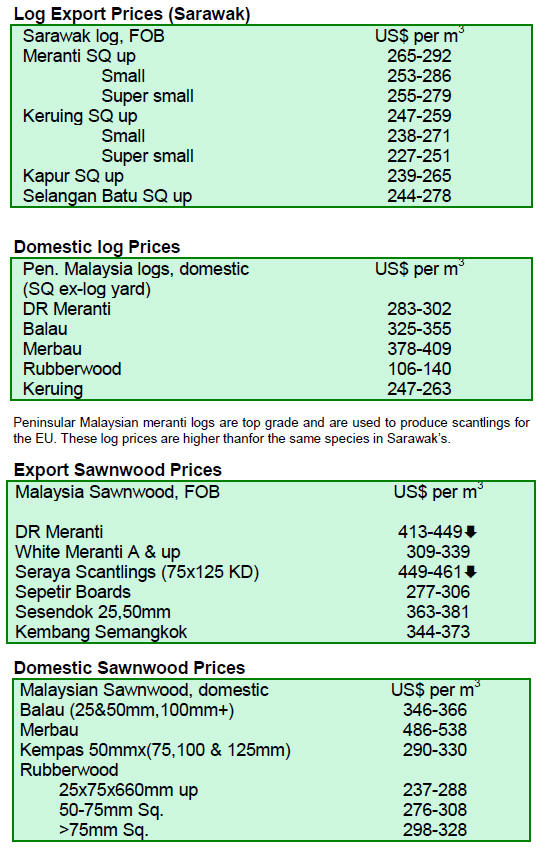
4.
INDONESIA
Indonesia expected to phase out raw rattan
exports
The Indonesian Industry Ministry is widely expected to
phase out the export of raw rattan over a three years period
commencing early 2012 in a bid to revive the local rattan
industry. A decision on this is expected in December 2011.
The Ministry had earlier submitted recommendations to
the Trade Ministry for a new rattan export regulation,
including a three-year export ban and a transition period.
The debate on a rattan export moratorium gained
momentum over the past few months as the 2009 Trade
Ministry regulations on rattan export quota expired in
August this year.
The previous regulations allowed for the export of a
total
of 35,000 tons of washed and sulphurised rattan of 4 to
16mm in diameter. It also stipulated that exports of semifinished
rattan such as sega and irit were permissible as
long as rattan producers produced a written commitment
that they have supplied rattan to the local industry.
Nevertheless, the rattan furniture industries and
associations regarded the regulations as ineffective in
assuring an adequate supply of raw rattan to meet the
demands of the local industry.
Rattan exporters counter-claimed that the local
industry
could not absorb the large volume of raw rattan produced
by Indonesian rattan producers.
The Industry Ministry estimated that local industry
could
absorb up to 63,000 tons of semi-finished rattan.
Indonesia is the world¡¯s largest rattan producer
accounting
for some 80% of worldwide production. Indonesia also
exported 33,033 tons of semi-finished rattan, valued at
US$32.32 million, while exporting 4,275 tons of rattan
furniture worth US$16.09 million in 2010, according to
data provided by the Industry Ministry.
Poor company results in Indonesia partly due to raw
material shortages
Indonesian publicly listed timber companies are citing
poor market conditions for Indonesian timber products as
the main reason for poor corporate performance in the
third quarter of this year.
In a consolidated financial report submitted to the
Indonesia Stock Exchange (IDX), PT Sumalindo Lestari
Jaya Tbk reported a nett loss of Rp.209.05 billion
(US$23.39 million) in the first nine months of 2011, after
reporting year-on-year profits of Rp.15.92 billion in 2010.
A sharp decline in export sales contributed to the
losses.
Sumalindo recorded sales of Rp278.08 billion up to the
end of the third quarter, a decline of about 43% from
Rp489.08 billion for the same period in 2010.
PT Sumalindo Lestari Jaya Tbk¡¯s activities comprise
mainly timber processing, logging activities and operation
of industrial timber plantations in addition to export,
import and local trading. It has a combined total
concession area of 448,986 ha. in East Kalimantan.
The group has six direct and indirect subsidiaries
engaged
in the logging business and operation of industrial timber
plantations.
It also has two subsidiaries that are engaged in the
power
generation and glue manufacturing industry. The company
and its subsidiaries have a combined total concession area
of up to 804,786 ha. in East Kalimantan.
Integrated timber product manufacturer PT Tirta
Mahakam Resources Tbk reported a better performance,
albeit with a nett loss of Rp1.03 billion up to the end of the
third quarter this year, after registering losses of Rp19.77
billion for the same period last year.
PT Tirta Mahakam Resources Tbk is involved in the
manufacturing and marketing of plywood and panelproducts.
It owns and operates an integrated wood
processing factory located in East Kalimantan. Its products
range from floor boards, general plywood, laminated
plywood, concrete panels, block boards, to wood
mouldings.
Its products are distributed and marketed locally in
Indonesia and are also exported to Japan, Taiwan, Korea,
Hong Kong, the US, Europe and India.
An analyst attributed the decline in profits of these
listed
companies to a shortage of raw material supply within
Indonesia which is said to be becoming acute.
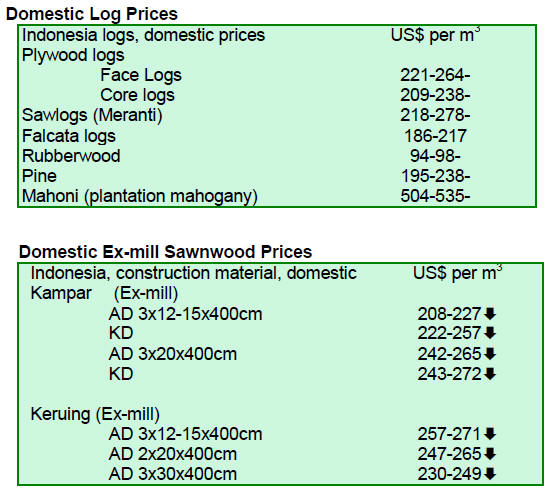
5. MYANMAR
Myanmar and Malaysia cooperate on timber
production
The Myanmar Timber Merchants Association (MTMA)
and the Malaysian Timber Industry Board (MTIB) are
working on areas of collaboration and are drafting a
memorandum of understanding between the two bodies.
The MTIB commented that Malaysia, with its
experience
of the complex supply chain in the timber industry, will be
able to offer advice and training to the Myanmar timber
industry to enhance efficiency and productivity in the
sector.
Malaysia export RM3.2 million worth of timber and
timber products to Myanmar in 2010, an increase from
RM1.7 million in 2009.
Exports of Malaysian furniture to Myanmar in 2010
stood
at RM2.4 million, with particleboard at RM648, 000 and
fibreboard at RM80, 000 in the same year.
Likewise in 2010, Malaysia imported RM75.9 million
worth of timber and timber products from Myanmar, a
41% increase over 2009, of which RM48.5 million was for
sawnwood and RM211, 000 was for furniture.
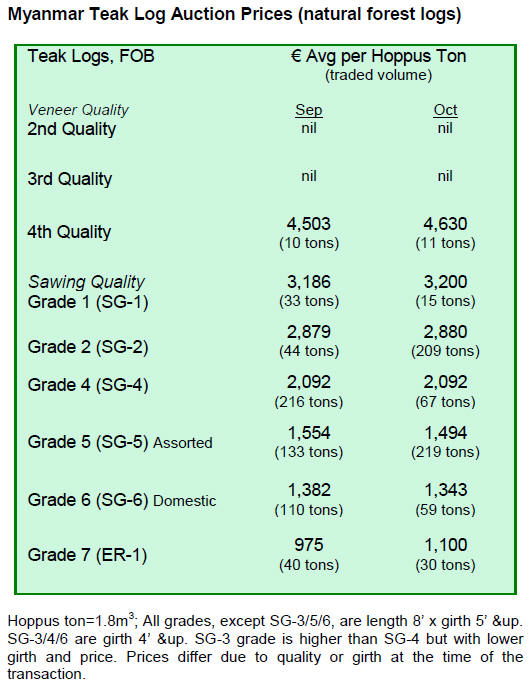
6.
INDIA
Weakening rupee continues to
undermine imports
Fluctuations in the Rupee/US Dollar exchange rate have
affected timber imports and the current 10% rise in import
costs due to the weakening of the Rupee is difficult for the
industry to absorb.
Analysts say that while exporting countries have
satisfactory log inventories, currency movements are
creating a mood of uncertainty in the Indian industry and it
is expected that orders for teak could ease.
Alternative timbers such as Meranti, Kapur, Merbau,
and
Balau are in demand as price structures for these species
are more favorable at present.
Importers now seeking wider range of species
Indian importers have now widened the range of species
they are importing to include hardwoods from Latin
America like ipe, camaru, greenheart and purpleheart for
use in the manufacture of flooring and furniture.
Logs harvested prior to monsoon attracting good
prices
Approximately 2,500 cu.m of teak logs were sold in South
Gujarat depots this month. Even though these were logs
felled before the monsoon, prices remained firm and sales
were brisk.
The best quality logs were at prices around 20%
higher
than the average for sales of this type of log. Analysts
report that good quality fresh logs have been steadily
arriving in the depots. The prices for domestic teak logs at
the recent auction are shown below.
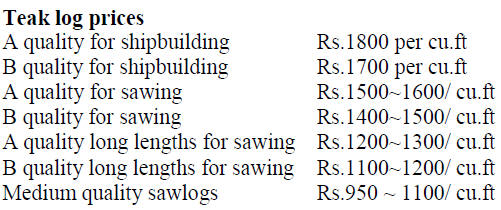
Depreciation of the Rupee and galloping inflation
of
concern to industry
Indian exports registered slower growth in September but
still surpassed levels in September last year (US$ 24.8
billion up from US$ 18.2 billion). Imports increased 17
percent in September reaching US$34.6 billion as against
US$29.5 billion in September last year.
European markets absorb about 20 % of India¡¯s
exports
and uncertainties in that market are likely to affect India¡¯s
export performance in the months to come.
On the domestic front, the depreciation of Indian
Rupee
against other major currencies and galloping inflation are
major worries for everyone running a business and the
government is revising downwards GDP growth estimates.
High interest rates and the economic uncertainties are
weighing heavily on the housing market.
The Indian economy withstood most of the negative
effects of the global recession of 2008/9 for over two years
by working successfully with Far East, Middle East and
Latin American markets. However these markets have
now started to feel the effects of the latest round of
financial weakness and the result of this is seen in
performances of Indian industries for the second quarter of
2011-12.
Indian exporters hope that the slight improvements
seen in
the North America economy and in some of the European
countries will continue so that exports begin to expand at
rates seen earlier this year.
India granted MFN status by Pakistan
Pakistan has announced it will grant most favoured nation
(MFN) status to India. India had granted MFN status to
Pakistan in 1996. Over the past few years the relationship
between the two countries has improved and a draft
bilateral visa agreement soon to be ratified will make it
easier for businessmen to move between the two countries.
One of the first advantages of the MFN will be
better
recording of trade data, the current indirect trade would
now be recorded as direct trade between the two countries.
India International Furniture Fair just concluded
The India International Furniture Fair, arranged by MP
International and the International Furniture Fair,
Singapore, has just ended at the Bombay Convention and
Exhibition Centre.
The fair attracted around 100 companies and leading
furniture makers from around the world such as Singapore,
Malaysia, China, Spain, India and Indonesia.
Manufacturers from just these six countries occupied
about 70 percent of the show space.
The show also hosted Indian manufactures and
importers
such as Artasia, Burosys Furniture, Decora Innovations,
Maspar, Mehar Industries, Laxmi International Export,
SunCity and Sharda India.
The Indian furniture show website puts the value of
the
formal Indian furniture market at around US$8 billion but
notes that this accounts for only 15% of the whole market.

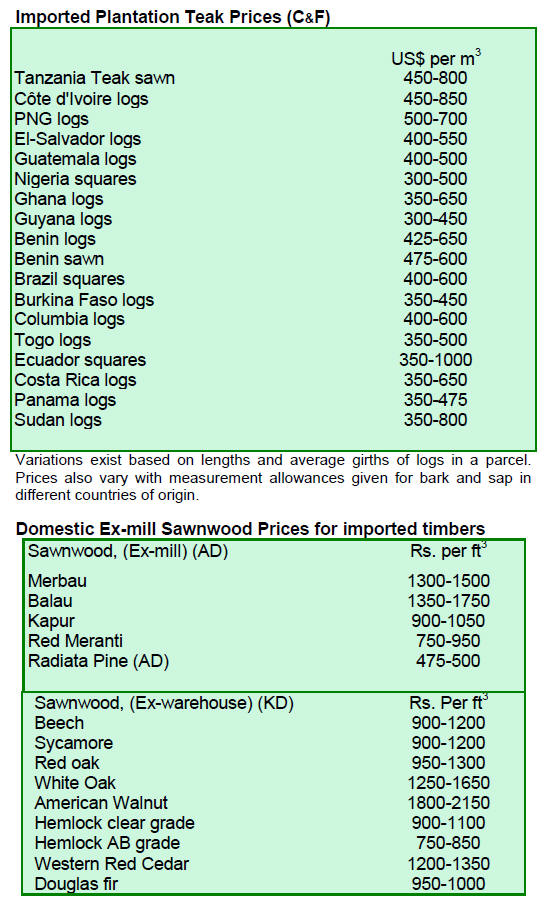
7. BRAZIL
Northeast investing in Arapiraca
furniture park
The Arapiraca municipality is the second largest city in the
State of Alagoas in terms of population and economic
importance, especially in the production and distribution
of furniture.
In order to strengthen the furniture sector the
Alagoas
State government is building a large industrial park in
Arapiraca specifically for wood products and furniture.
The furniture park is being built in S¨ªtio Capim, some 6
km from the city centre.
The goal is to restructure and strengthen the
furniture
sector and related-companies as well as to attract new
small, medium and large-sized companies to the region.
This, it is anticipated, will generate more jobs and boost
growth. The park project includes the building of a
warehouse and a showroom to exhibit furniture.
The construction of this industrial park is
expected to
boost the productivity of the furniture sector. The park will
provide for interaction among companies and allow for
further development of the furniture sector thus improving
the competitiveness of companies in the domestic furniture
market.
Furniture sector may loose tax exemption
The President of Brazil signed a set of regulations in
August 2011 to stimulate industrial growth. The new
industrial policy, called the ¡°Plano Brasil Maior¡± (Brazil
Major Plan), aims to help the private sector in the current
difficult trading conditions through reduced taxes.
There are several factors of concern to
manufacturers
including the difficulty in trading when the Real is so
strong, the rapid rise in imports and the risk of a new
global economic crisis.
The governments¡¯ plan includes measures to improve
access to financing through the Brazilian Development
Bank (BNDES), incentives for innovations, tax reductions,
export promotion and trade protection.
The government plan proposes to remove the
furniture
sector from the list of industries subject to the tax
reduction. However the proposed alternative tax of 1.5%
applied to the gross sales of the industry, which replaces
the 20% tax on employer social security, is considered a
setback by many entrepreneurs in the furniture industry.
This was taken up with the authorities by
manufacturers
but they failed to secure agreement for a reduction of the
tax rate from 1.5% to 0.75% as requested by the furniture
sector.
This prompted the furniture industry to request
withdrawal
of sector from the list of industries subject to tax
reductions so as to avoid a further burden on the sector.
Nevertheless, companies will keep the current export
benefits. The dialogue between the government and the
furniture sector continues.
Assistance by Brazil in forest monitoring
intensifies
Technology for monitoring forest cover developed by the
National Institute for Space Research (INPE) and used to
detect deforestation is being transferred to other countries.
The pressure on countries to increase control and
monitoring over their tropical forest areas grows as
climate negotiations advance. INPE developed a
monitoring system for tracking deforestation and the
technique has proven effective domestically and found to
be applicable in other countries.
The Brazilian Government, in partnership with the
United
Nations Food and Agriculture Organization, the Amazon
Cooperation Treaty Organization and the Japan
International Cooperation Agency, has established training
programmes in countries such as Mexico, Gabon, Guyana,
Congo, Papua New Guinea and Vietnam, many of which
intend to utilise this monitoring system.
Six international groups from Venezuela, Bolivia,
Colombia, Peru and Ecuador are currently receiving
training in Bel¨¦m, Par¨¢ state, in the Amazon region in
Brazil. African countries also are also interested in the
system. The Congo, which has the world¡¯s second largest
rainforest, Mozambique and Angola have sent personnel
to be trained in Brazil.
The satellite monitoring of the Amazon rainforest
has
gained momentum with the creation of software called
¡°Terra Amazon¡±. The system collects images from the
U.S. Landsat satellite and transforms them into maps
defining various ecosystems and allows an evaluation of
forest degradation at different stages.
Furniture industry calls for an end to Argentine
customs delays
The ongoing customs clearance delays in Argentina on
imported Brazilian products, including furniture from the
industries in Rio Grande do Sul, has led the Association of
Furniture Industries to ask the Federal Government to take
action.
The State of Rio Grande do Sul has suffered a
drastic
decline in their exports of furniture to Argentina since the
delays in clearance began in 2009.
Brazilian exporters complain that customs
authorities in
Argentina do not respect the internationally adopted norm
of a period of 60 days for issuing import licenses.
It has been estimated that over R$ 7 million in
furniture
produced in the State of Rio Grande are being delayed
because licenses take an average of 136 days to be issued.
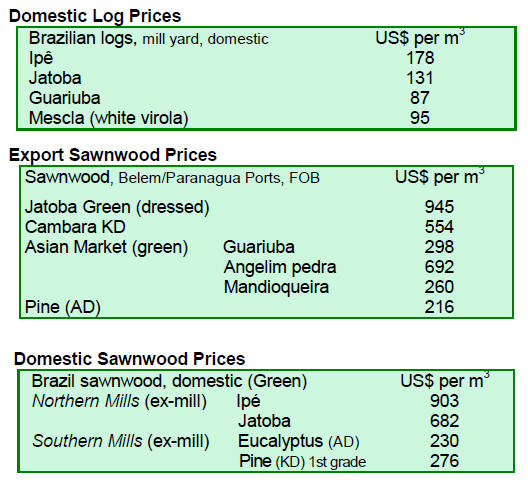
8. PERU
State urged to invest more
to prevent illegal logging
A representative of the Environment, Public Services and
Indigenous Peoples Ombudsman office has urged the State
to invest more to strengthen the management of the natural
forests to ensure the sustainable use of resources, to
combat illegal logging and prevent the loss of the
country¡¯s natural heritage.
Journalists update understanding on forest
resource management
The Ministry of Agriculture (MINAG), and the College of
Journalists of Peru (CPP), issued guidelines and arranged a
workshop for journalists and social communicators in
order to broaden their understanding of management of
forest resources and wildlife.
It was reported that the workshop was given by
specialists
from the Directorate General of Forestry and Wildlife
(DGFFS) and the Technical Administration of Forestry
and Wildlife (ATFF) and the Peruvian Society of
environmental (SPDA).
The workshop objective was to provide new and
useful
environmental information, enabling professionals to
inform the media of the facts relating to the care of the
environment and sustainable management of natural
resources.
Latin American Forestry Congress concluded in
Lima
The Latin American Forestry Congress (V CONFLAT)
with the theme "The Future of the World Depends on
Forests" has just concluded. The aim of the congress was
to promote the development of forestry on the continent.
Some 700 participants from various countries in Latin
America attended the congress. ITTO was represented by
Peruvian engineer, John Leigh.
This international event was sponsored by the
Ministry of
Agriculture (MINAG) along with public and private sector
entities.
Minister calls for protection of 50 million
hectares of natural areas
The Environment Minister, Ricardo Giesecke, said
recently that at least 50 million hectares of Peru¡¯s natural
areas need to be protected in collaboration with
communities. This was stated during a training workshop
for 73 heads of natural areas protected by the state,
organized by the National Natural Protected Areas by the
State, SERNAMP, a public body under the Ministry of
Environment.
¡®Green¡¯ credits awarded to Peru to preserve the
environment
The Inter-American Development Bank, will reportedly
award two 'green' credits to Peru worth a total of US$50
million to promote environmental sustainability in Peru.
Activities to be financed include intervention in water
management, sustainable agriculture, energy, climate
change, natural disaster preparedness and solid waste
management.
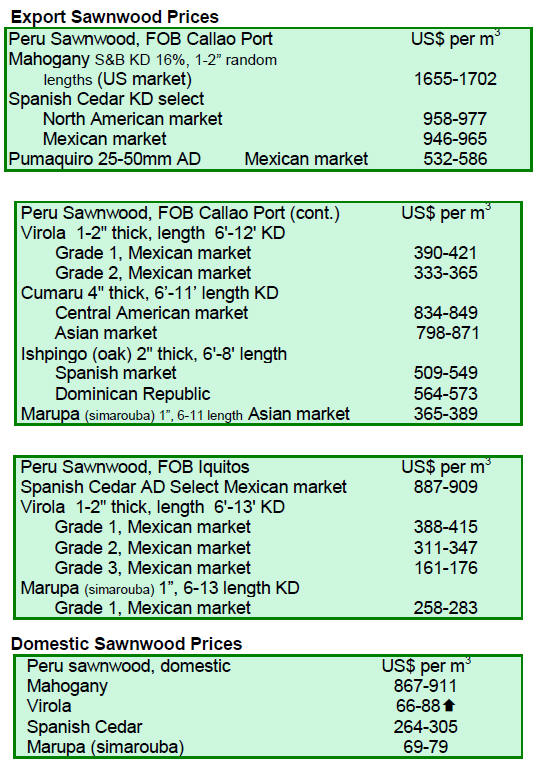
9.
GUYANA
Guyana log prices remain
firm
While there were no exports of Greenheart logs in the
period under review, Purpleheart logs were traded and
prices remain firm for all categories. On the other hand,
Mora log prices showed considerable variation depending
on the specifications and prices for only two categories
increased compared to levels seen in the previous period.
Mora sawnwood prices firm on export market
Greenheart (select) sawnwood recorded a decline in the
top end prices from US$975 to US$806 per cubic metre
for this period. Undressed Greenheart (sound) prices
remained stable for this fortnight period.
In contrast, undressed Purpleheart (select)
sawnwood
secured better prices rising from US$912 to US$997 per
cubic metre for this period.
Undressed Mora sawnwood prices continue firm on the
export market for this fortnight. Undressed sawnwood was
shipped to various destinations including the Caribbean,
Europe, Middle East and North America.
Dressed Greenheart sawnwood was in demand and
prices
firmed from US$848 to US$1,350 per cubic metre, while
dressed Purpleheart sawnwood prices remain unchanged.
Plywood, poles and shingles in demand in export
markets
Baromalli plywood prices fell from US$708 to US$500
per cubic metre for this fortnight period in comparison to a
price of around US$700 about a month ago.
Exports of roundwood, mainly posts and piles, made
a
notable contribution towards to total export earnings. Piles
attracted favourable prices as much as US$703 per cubic
metre with a significant portion of exports going to North
America.
Splitwood (Shingles) also attracted good prices on
the
export market reaching as high as US$1,200 per cubic
metre. This product has always captured the attention of
the endusers in the Caribbean due to its durability and
ability to withstand weathering.
Barama celebrates 20 years in Guyana
Barama¡¯s Chief Executive Mr. Clement Ooi has revealed
that after being granted 1.6 million hectares of forests, the
Malaysian-based Company has invested some GYD$25
bil. in Guyana over the past 20 years.
Barama is the largest foreign investor in Guyana¡¯s
timber
sector and is involved in sawmilling and processing
operations. The Barama complex includes two sawmills, a
veneer plant and a large shipping facility. Barama
stimulated a transformation in the forestry sector
especially with the introduction of new and modern
processing technologies.
The Guyana Forestry Commission has said that this
company has expanded to be the largest interior road
developer and a pioneer of a sustainable management
model under the guidance of the Edinburgh Centre for
Tropical Forest. The Government of Guyana has over the
years, created the necessary investment climate to attract
foreign investors.
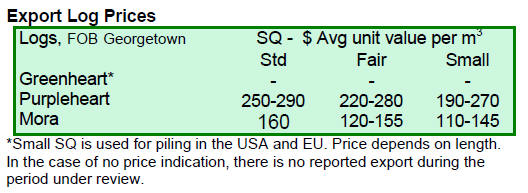
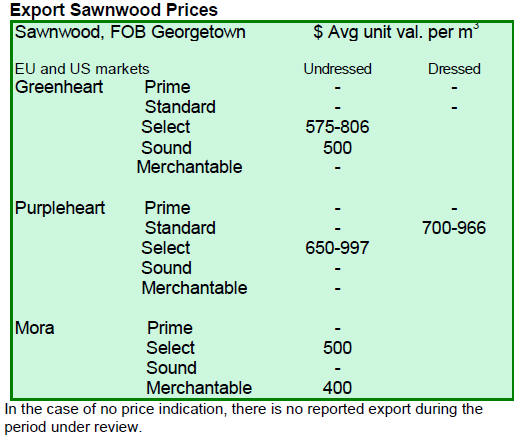
Related News: